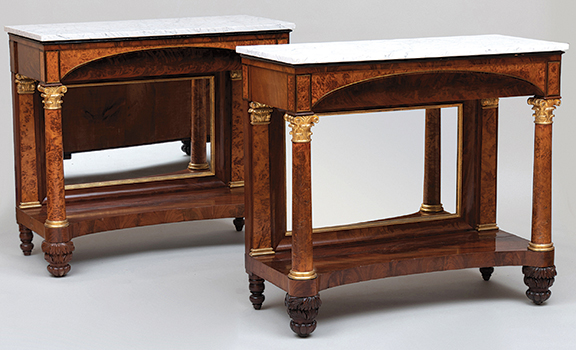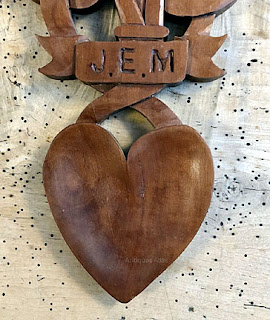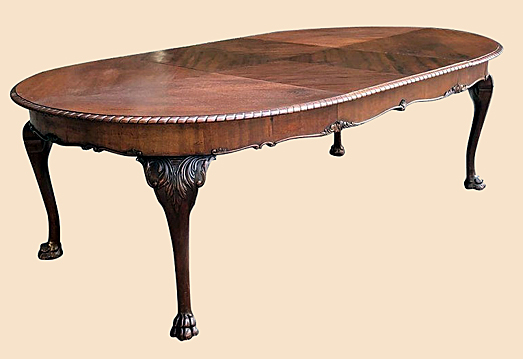QUESTION: My great grandfather was an officer in the British Army. He owned a chest that has been in our family ever since. The unusual thing about this chest is that it comes apart into several sections. We’ve always wondered why. What can you tell me about his chest?
ANSWER: With the rise and expansion of the British Empire in the 19th and 20th centuries the demand by the military for portable furniture increased. People referred to any furniture specifically designed to break down or fold for ease of travel as campaign furniture, specifically designed to be packed up and carried on the march.
 Campaign furniture has been used by traveling armies since the time of Julius Caesar, known to carry elaborate furnishings on his month-long military campaigns.
Campaign furniture has been used by traveling armies since the time of Julius Caesar, known to carry elaborate furnishings on his month-long military campaigns.
From foldable work chairs and desks to portable wooden mosaic floors, the interior of a Roman general’s tent would have been lavishly decorated. In order to simulate the comforts of home while on the move, those furnishings needed to be easy to pack up and transport. A prominent example was the curule seat, the traditional chair of Roman magistrates and field commanders, which could be folded up for transportation. But in modern times, it came to be associated with British Army officers, who sought to create a palatial feel while on the road.
 The most common type of campaign furniture was the chest of drawers, often referred to as a military chest or campaign chest. Most often made of mahogany, teak, camphor, cedar, or pine, it broke down into two sections and had removable feet. This type of chest also had brass corners and strapwork to offer some protection while traveling.
The most common type of campaign furniture was the chest of drawers, often referred to as a military chest or campaign chest. Most often made of mahogany, teak, camphor, cedar, or pine, it broke down into two sections and had removable feet. This type of chest also had brass corners and strapwork to offer some protection while traveling.
Some pieces of campaign furniture also had brass caps on the tops of legs, hinges in unusual places, protruding bolts, or X-frame legs depending on the functionality of the piece. However, some pieces were designed to be up to date and fashionable, looking much like domestic furniture. Ross and Company of Dublin were innovators of campaign furniture design and much of their work is obviously Victorian in period.
 Campaign furniture came in a variety of forms, from portable beds to collapsible candlesticks. The numerous items specifically made for travel include a variety of types of bed from four poster or tent beds to chairs that would extend for sleeping; large dining tables, dining chairs, easy chairs, sofas and couches, chests of drawers, book cabinets, washstands, wardrobes, shelves, desks, mirrors, lanterns and candlesticks, canteens of silver, cooking equipment, toiletry equipment, and box-seats for chamber pots were all made to be portable.
Campaign furniture came in a variety of forms, from portable beds to collapsible candlesticks. The numerous items specifically made for travel include a variety of types of bed from four poster or tent beds to chairs that would extend for sleeping; large dining tables, dining chairs, easy chairs, sofas and couches, chests of drawers, book cabinets, washstands, wardrobes, shelves, desks, mirrors, lanterns and candlesticks, canteens of silver, cooking equipment, toiletry equipment, and box-seats for chamber pots were all made to be portable.
There seemed no limit to the number of items an officer would take with him if he could afford to. How well his tent was outfitted could indicate his social standing.
 By the mid-19th century the demand for campaign furniture encouraged manufacturers to invent unusual and interesting pieces that offered ease in dismantling or the compactness of their storage. Makers produced tables cleverly hinged to fold down into a box the size of a briefcase. Chess board boxes would contain tripod legs and a telescopic column to convert into a table. Chairs would break down to a minimal size, and often converted into a sedan-chair. The need for each piece to pack up quickly into a portable package with minimal complication drove innovation. By the late 19th century, over 85 manufacturers were producing campaign furniture in the London area alone. That period also saw campaign furniture growing increasingly unique and opulent.
By the mid-19th century the demand for campaign furniture encouraged manufacturers to invent unusual and interesting pieces that offered ease in dismantling or the compactness of their storage. Makers produced tables cleverly hinged to fold down into a box the size of a briefcase. Chess board boxes would contain tripod legs and a telescopic column to convert into a table. Chairs would break down to a minimal size, and often converted into a sedan-chair. The need for each piece to pack up quickly into a portable package with minimal complication drove innovation. By the late 19th century, over 85 manufacturers were producing campaign furniture in the London area alone. That period also saw campaign furniture growing increasingly unique and opulent.
Much of the early portable furniture would have been made to order. Soldiers often asked their local cabinet makers to take a domestic design and adapt it for travel. As demand grew, a number of well known designers, including Chippendale, Sheraton and Gillows, considered portable furniture. The end of the 18th century witnessed the rise of specialist makers, with Thomas Butler and Morgan & Sanders being the most recognized. The number of such specialists increased during the 19th century.
 The beginning of the 20th century saw changes in the way armies conducted war. During the Boer War in South Africa, the British realized that their adversaries could move quickly and discovered that their own mobile units weren’t quite as mobile as they had thought. The early 20th century also saw the rise of the motor car which meant that travel was faster, making it less of a necessity for officers to equip themselves for a long journey, creating less of a demand for campaign furniture.
The beginning of the 20th century saw changes in the way armies conducted war. During the Boer War in South Africa, the British realized that their adversaries could move quickly and discovered that their own mobile units weren’t quite as mobile as they had thought. The early 20th century also saw the rise of the motor car which meant that travel was faster, making it less of a necessity for officers to equip themselves for a long journey, creating less of a demand for campaign furniture.
To read more articles on antiques, please visit the Antiques Articles section of my Web site. And to stay up to the minute on antiques and collectibles, please join the over 30,000 readers by following my free online magazine, #TheAntiquesAlmanac. Learn more about "In the Good Ole Summertime" in the 2024 Summer Edition, online now. And to read daily posts about unique objects from the past and their histories, like the #Antiques and More Collection on Facebook.















































